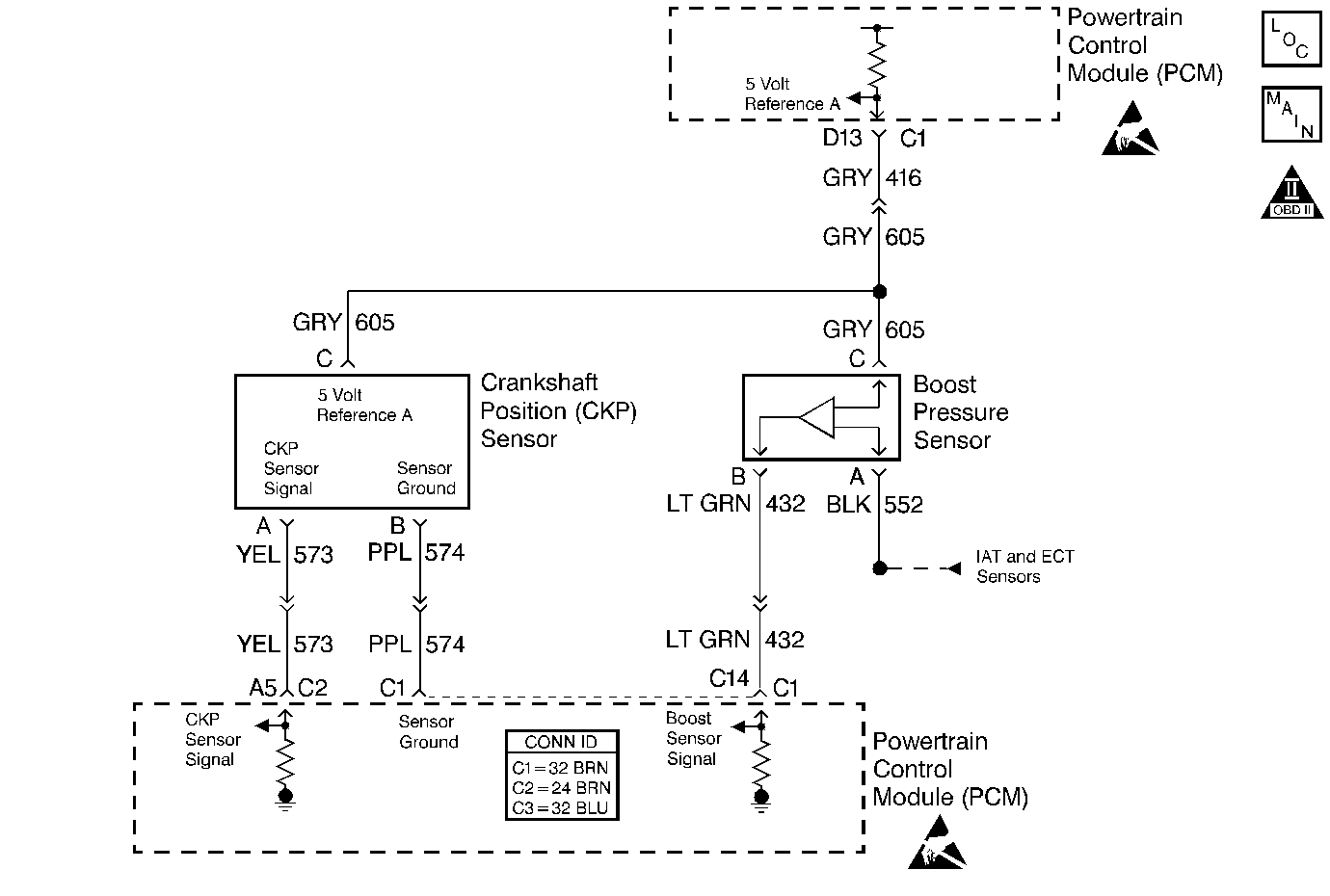
Circuit Description
The PCM operates a solenoid to control boost. This solenoid is normally open. By providing a ground path, the PCM energizes the solenoid which allows vacuum to pass to the wastegate valve. During normal operation, the PCM compares the wastegate duty cycle signal with the boost signal, and makes corrections to the duty cycle accordingly.
Conditions for Running the DTC
The ignition switch in the on position.
Conditions for Setting the DTC
| • | The boost pressure is less than 40 kPa. |
| • | All diagnostic set conditions met for 2 seconds. |
Action Taken When the DTC Sets
| • | The PCM illuminates the malfunction indicator lamp (MIL) on the second consecutive drive trip the diagnostic runs and fails. |
| • | The PCM records the operating conditions at the time the diagnostic fails. The first time the diagnostic fails, the Failure Records store this information. If the diagnostic reports a failure on the second consecutive drive trip, the Freeze Frame records the operating conditions at the time of failure and updates the Failure Records. |
Conditions for Clearing the MIL/DTC
| • | The PCM will turn the MIL OFF after three consecutive trips without a fault condition. |
| • | A History DTC will clear after forty consecutive warm-up cycles, if this or any other emmision related diagnostic does not report any failures. |
| • | Use of a scan tool will clear the DTC codes. |
Diagnostic Aids
Very little boost can be attained by revving the engine in neutral. If the boost sensor signal circuit is open or shorted to ground, the boost solenoid will show a zero duty cycle.
An intermittent may be caused by the following:
| • | Poor connections. |
| • | Rubbed through wire insulation. |
| • | Broken wire inside the insulation. |
Test Description
Number(s) below refer to the step number(s) on the Diagnostic Table.
-
This step will determine if DTC P0237 is the result of a hard failure or an intermittent condition.
-
This step simulates conditions for a DTC P0237. If the PCM recognizes the change, the PCM and signal circuit are OK.
-
In this step, components that share the 5 volt reference can cause the reference voltage to be shorted to ground. This can be checked by disconnecting each component that shares the 5 volt reference one at a time, including the PCM while checking for continuity on that circuit to chassis ground.
Step | Action | Value(s) | Yes | No | ||||
|---|---|---|---|---|---|---|---|---|
1 |
Important: Before clearing any DTCs, use the scan tool Capture Info to save the Freeze Frame and Failure Records for reference. The control module's data is deleted once the Clear Info function is used. Did you perform the Powertrain On-Board Diagnostic (OBD) System Check? | -- | ||||||
Does the scan tool display a Boost Pressure less than or equal to the specified value? | 40 kPa | |||||||
Does the scan tool display a Boost Pressure greater than or equal to the specified value? | 202 kPa | |||||||
4 |
Does the scan tool display a Boost Pressure greater than or equal to the specified value? | 202 kPa | ||||||
5 | The DTC is intermittent. If no additional DTCs are stored, refer to Diagnostic Aids. If additional DTCs are stored, refer to those table(s) first. Are any additional DTCs stored? | -- | Go to the Applicable DTC Table | Go to Diagnostic Aids | ||||
6 |
Did you perform a repair? | -- | ||||||
7 |
Did you perform a repair? | -- | ||||||
8 |
Did you perform a repair? | -- | ||||||
Did you perform a repair? | -- | |||||||
10 | Replace the boost sensor. Refer to Boost Sensor Replacement . Is the action complete? | -- | -- | |||||
11 |
Did you perform a repair? | -- | ||||||
12 |
Important: The new PCM must be programmed. Refer to Powertrain Control Module Replacement/Programming . Replace the PCM. Is the action complete? | -- | -- | |||||
13 |
Does the scan tool indicate the diagnostic Passed? | -- | ||||||
14 | Does the scan tool display any additional undiagnosed DTCs? | -- | Go to the Applicable DTC Table | System OK |
